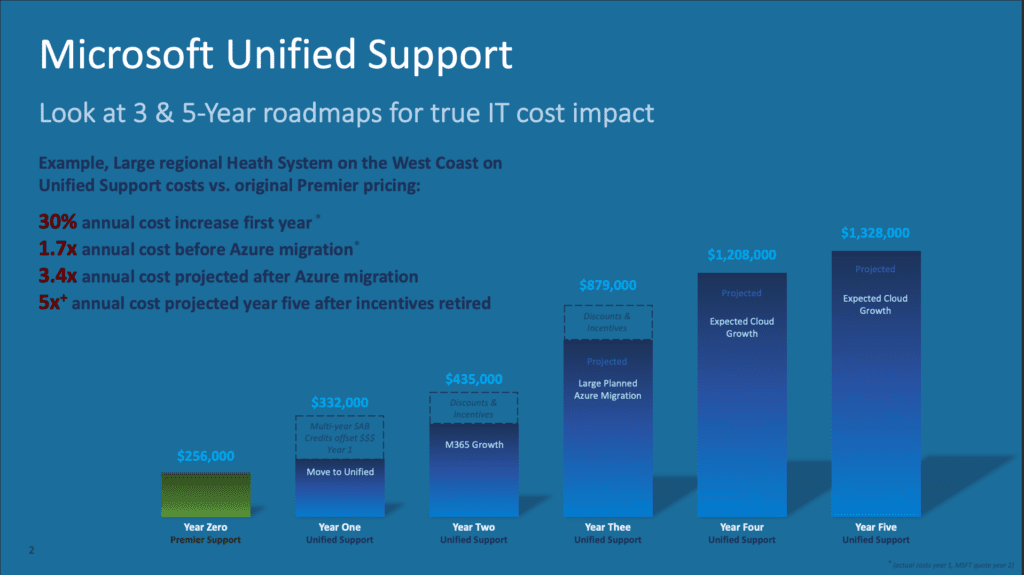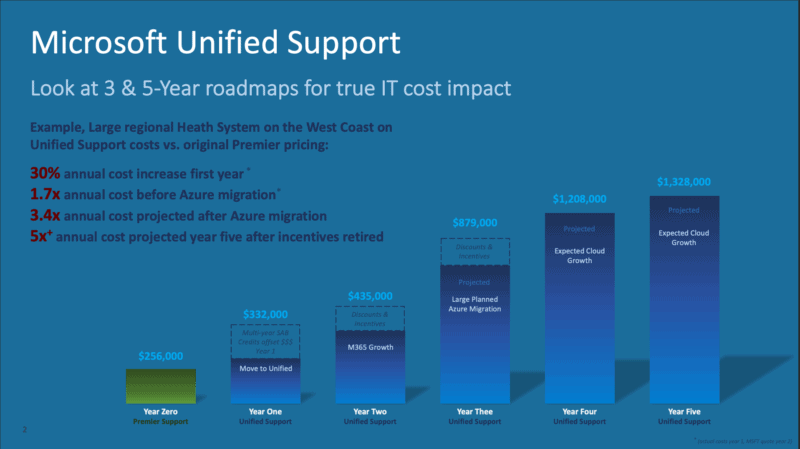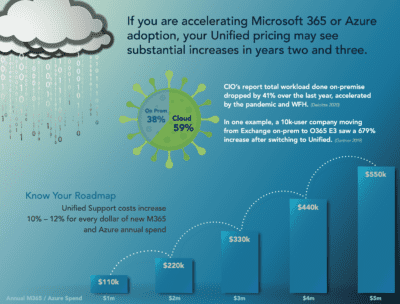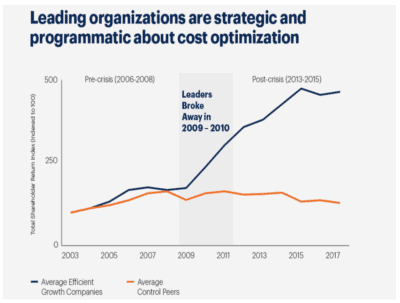
How Much Does Microsoft Unified Support Really Cost?.
HOW MUCH DOES UNIFIED SUPPORT REALLY COST?
Unified Support’s unlimited Microsoft software support initially looks attractive but often results in significant cost increases for enterprises. Unified Support is forecasted to cost 2-5x more than Premier over the next 5 years and a 7-9 % increase in most Enterprise Agreements (EA).
Initiatives: Negotiating Microsoft Contracts | Strategic IT Cost Optimization
Audience: CIO and IT Executives | Sourcing, Procurement and Vendor Management
How is Microsoft Unified Support Cost Calculated?
- The Unified Support Core Plan has a minimum cost of $25,000 and includes 6% of your Microsoft 365 spend and 8% of your Azure and Dynamics spends.
- The Unified Support Advanced Plan has a minimum cost of $50,000 and includes 8% of your Microsoft 365 spend and 10% of your Azure and Dynamics spends.
- The Unified Support Performance Plan has a minimum cost of $175,000 and includes 10% of your Microsoft 365 spend and 12% of your Azure and Dynamics spends.
Compare the 3 Unified plans in more detail to Premier to estimate year 1 cost reduction and years 2-5 cost avoidance opportunity.
| Support Features |
Microsoft Premier Support |
US Cloud Premier Support |
Unified Support Core Plan |
Unified Support Advanced Plan |
Unified Support Performance Plan |
|---|---|---|---|---|---|
| Support Cost |
$300 per hour |
$200 per hour |
8% of annual software spend |
10% of annual software spend |
12% of annual software spend |
| Minimum Contract |
$25,000 | $20,000 | $25,000 | $50,000 | $175,000 |
| Response Time |
1 hr critical, 2 hr standard |
15 min critical, 15 min standard |
1 hr critical, 8 hr standard |
1 hr critical, 4 hr standard |
30 min critical, 4 hr standard |
Table data sources: Microsoft Q4 FY2022 Cost for Unified and Premier Support, US Cloud Premier Support Pricing Q3 2022
5 Year Unified Support Forecasted Cost
At least 3 months prior to your Unified renewal, conduct an audit on the renewal proposal in order to fully understand how the price is calculated. Your audit rights allow you to see and fully understand the look-back over a 3-5 year timespan.
Ask for the information as spreadsheet, not a PDF. The information should include: contract number and type (Enterprise Agreement, MPSA, etc…) and a detailed list of every product in the contract, annual cost, and type.
Once you have a handle on what Microsoft products and services you need and that drive your Unified Support cost, put them in a spreadsheet and apply anticipated growth across the various products for 5 years.
In addition, forecast SAB credits and SA discounts that will be lost in 2023. This analysis will allow you to arrive at an effective Unified Support cost forecast for your enterprise.
Azure is a Key Unified Support Cost Driver
Unified Support costs are pinned to your Microsoft cloud services spend. Of which the biggest cost is Azure at 12%.
Currently, analysts have both Amazon and Microsoft stocks as strong buys due to one singular demand from enterprise customers: datacenter consolidation.
According to Microsoft, datacenter consolidation and migration helps customers reduce costs, improve service levels, and drive business agility.
More granular benefits include reduction of CapEx and OpEx expenses, standardized technologies, reducing VM server sprawl and migration to Azure-based private or public IaaS.
As IT leaders consolidate data centers to speed up their digital transformation efforts and meet CFO cost reduction mandates, they are seeing their Azure consumption increase significantly as they close datacenters and move their data to Azure. In doing so, Unified support costs are rising also.
Microsoft Unified Support Immediate Cost Reduction
Sourcing, Procurement and Vendor Management (SPVM) are incentivized to reduce existing IT costs as part of the CFO mandate to the CIO to continuously optimize IT costs.
In the midst of economic uncertainty, many industries are looking for ways to rapidly cut IT costs and use the savings to reinvest in growth.
Third-party Microsoft support is a Gartner recognized IT cost saver and particularly compelling when overlaying 5 year Microsoft-centric IT roadmaps and skyrocketing Unified support costs.
Microsoft Unified Support Future Cost Avoidance
CFOs value cost avoidance above all else because it maintains budget needed for strategic IT investments that drive new growth.
Industry-leading Sourcing, Procurement and Vendor Management (SPVM) are keenly aware of this mindset and give cost avoidance priority when looking at sourcing new IT vendors. Those IT vendors that can both avoid new costs and reduce existing rise to the top.
66% of companies surveyed now expect to pursue IT cost avoidance strategies this year, up from just 38% pre-recession. – Deloite
Gartner research shows that leading companies take a proactive and strategic approach to cost optimization — strategically cutting existing and avoiding new costs while funding growth at the bottom of the business cycle.
This approach better equips them to sustain through headwinds and unknowns — and pull ahead amid and beyond the uncertainty and disruption of crises like the global recession.
Unified Support Cost Case Studies
Small Enterprise Case Study – 1.7x Unified Cost Increase
Scenario: Regional healthcare provider with non-profit cancer research arm moved its on-premise data warehouse to Azure for more efficient machine learning around its cancer research efforts. After performing its due diligence, the organization moved to third-party Microsoft support provider US Cloud after 1 year of Unified support.
Industry: Healthcare
Employees: 7,000
Key driver: Azure machine learning
Unified Support Cost Reduction Year 1: 31%
Unified Support Cost Avoidance Years 2-5: 142%
Large Enterprise Case Study – 5x Unified Cost Increase
Scenario: Fortune 500 bank consolidating data centers and moving production VM workloads to Azure. The bank kept its 3 main geographically dispersed data centers for disaster recovery and off Azure network backups. After 5 year forecast analysis, the bank replaced Microsoft with US Cloud after 2 years in Unified.
Industry: Financial
Employees: 80,000
Key driver: Datacenter consolidation
Unified Support Cost Reduction Year 1: 43%
Unified Support Cost Avoidance Years 2-5: 461%







